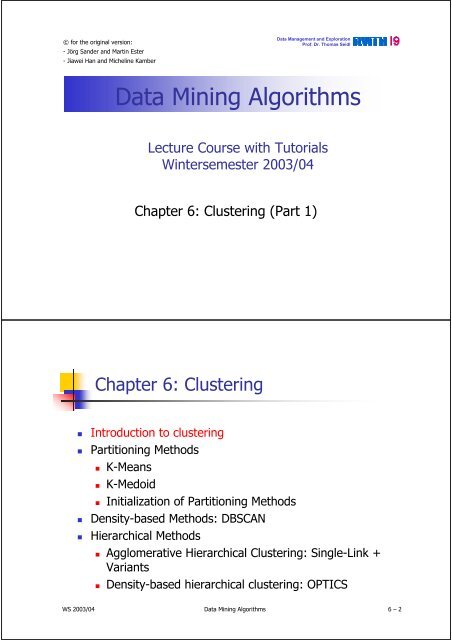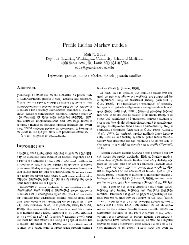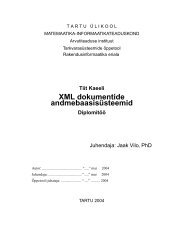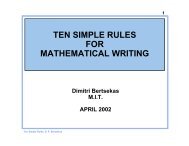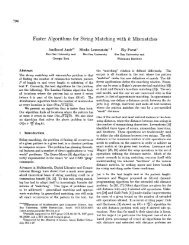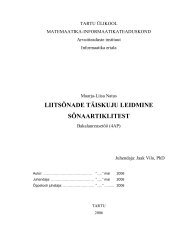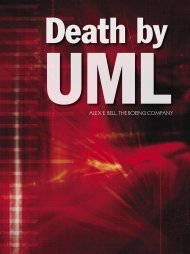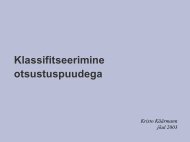Data Mining Algorithms - Quretec
Data Mining Algorithms - Quretec
Data Mining Algorithms - Quretec
You also want an ePaper? Increase the reach of your titles
YUMPU automatically turns print PDFs into web optimized ePapers that Google loves.
© for the original version:<br />
-JörgSander and Martin Ester<br />
- Jiawei Han and Micheline Kamber<br />
<strong>Data</strong> Management and Exploration<br />
Prof. Dr. Thomas Seidl<br />
<strong>Data</strong> <strong>Mining</strong> <strong>Algorithms</strong><br />
Lecture Course with Tutorials<br />
Wintersemester 2003/04<br />
Chapter 6: Clustering (Part 1)<br />
Chapter 6: Clustering<br />
• Introduction to clustering<br />
• Partitioning Methods<br />
• K-Means<br />
• K-Medoid<br />
• Initialization of Partitioning Methods<br />
• Density-based Methods: DBSCAN<br />
• Hierarchical Methods<br />
• Agglomerative Hierarchical Clustering: Single-Link +<br />
Variants<br />
• Density-based hierarchical clustering: OPTICS<br />
WS 2003/04 <strong>Data</strong> <strong>Mining</strong> <strong>Algorithms</strong> 6 – 2
What is Clustering?<br />
• Grouping a set of data objects into clusters<br />
• Cluster: a collection of data objects<br />
• Similar to one another within the same cluster<br />
• Dissimilar to the objects in other clusters<br />
• Clustering = unsupervised classification (no predefined classes)<br />
• Typical usage<br />
• As a stand-alone tool to get insight into data distribution<br />
• As a preprocessing step for other algorithms<br />
WS 2003/04 <strong>Data</strong> <strong>Mining</strong> <strong>Algorithms</strong> 6 – 3<br />
Measuring Similarity<br />
• To measure similarity, often a distance function dist is used<br />
• Measures “dissimilarity” between pairs objects x and y<br />
• Small distance dist(x, y): objects x and y are more similar<br />
• Large distance dist(x, y): objects x and y are less similar<br />
• Properties of a distance function<br />
• dist(x, y) ≥ 0<br />
• dist(x, y) = 0 iff x = y (definite) (iff = if and only if)<br />
• dist(x, y) = dist(y, x) (symmetry)<br />
• If dist is a metric, which is often the case:<br />
dist(x, z) ≤ dist(x, y) + dist(y, z) (triangle inequality)<br />
• Definition of a distance function is highly application dependent<br />
• May require standardization/normalization of attributes<br />
• Different definitions for interval-scaled, boolean, categorical,<br />
ordinal and ratio variables<br />
WS 2003/04 <strong>Data</strong> <strong>Mining</strong> <strong>Algorithms</strong> 6 – 4
Example distance functions I<br />
• For standardized numerical attributes, i.e., vectors x = (x 1 , ..., x d ) and<br />
y = (y 1 , ..., y d ) from a d-dimensional vector space:<br />
• General L p -Metric (Minkowski-Distance):<br />
dist(<br />
x,<br />
y)<br />
=<br />
p<br />
d<br />
∑<br />
i=<br />
1<br />
( x i<br />
− y i<br />
)<br />
p<br />
• Euclidean Distance (p = 2):<br />
dist(<br />
x,<br />
y)<br />
=<br />
d<br />
∑<br />
i=<br />
1<br />
( x i<br />
− y i<br />
)<br />
2<br />
• Manhattan-Distance (p = 1): dist(<br />
x,<br />
y)<br />
=<br />
• Maximum-Metric (p = ∞):<br />
d<br />
∑<br />
i=<br />
1<br />
x i<br />
− y i<br />
{ x − y , ≤ i ≤ d}<br />
dist(<br />
x,<br />
y)<br />
= max 1<br />
i<br />
i<br />
• For sets x and y:<br />
dist(<br />
x,<br />
y)<br />
=<br />
x ∪ y − x ∩ y<br />
x ∪ y<br />
WS 2003/04 <strong>Data</strong> <strong>Mining</strong> <strong>Algorithms</strong> 6 – 5<br />
Example distance functions II<br />
• For categorical attributes:<br />
d<br />
∑<br />
= ⎩ ⎨⎧ 0 if x<br />
=<br />
=<br />
= i<br />
y<br />
dist( x,<br />
y)<br />
δ ( xi<br />
, yi<br />
) where δ ( xi<br />
, yi<br />
)<br />
i 1 1 else<br />
• For text documents:<br />
• A document D is represented by a vector r(D) of frequencies of the<br />
terms occuring in D, e.g.,<br />
( f ( ti,<br />
D)<br />
),<br />
ti<br />
∈ }<br />
r( d)<br />
= {log<br />
T<br />
where f (t i , D) is the frequency of term t i in document D<br />
• The distance between two documents D 1<br />
and D 2<br />
is defined by the<br />
cosine of the angle between the two vectors x = r(D 1<br />
) and y = r(D 2<br />
):<br />
x,<br />
y<br />
dist(<br />
x,<br />
y)<br />
= 1−<br />
x ⋅ y<br />
where 〈 .,.〉is the inner product and | .|is the length of vectors<br />
i<br />
WS 2003/04 <strong>Data</strong> <strong>Mining</strong> <strong>Algorithms</strong> 6 – 6
General Applications of Clustering<br />
• Pattern Recognition and Image Processing<br />
• Spatial <strong>Data</strong> Analysis<br />
• create thematic maps in GIS by clustering feature spaces<br />
• detect spatial clusters and explain them in spatial data mining<br />
• Economic Science (especially market research)<br />
• WWW<br />
• Documents<br />
• Web-logs<br />
• Biology<br />
• Clustering of gene expression data<br />
WS 2003/04 <strong>Data</strong> <strong>Mining</strong> <strong>Algorithms</strong> 6 – 7<br />
A Typical Application: Thematic Maps<br />
• Satellite images of a region in different wavelengths<br />
• Each point on the surface maps to a high-dimensional feature<br />
vector p = (x 1 , …, x d ) where x i is the recorded intensity at the<br />
surface point in band i.<br />
• Assumption: each different land-use reflects and emits light of<br />
different wavelengths in a characteristic way.<br />
(12),(17.5) •<br />
••••<br />
•••<br />
••••<br />
•••• ••••<br />
(8.5),(18.7) •••••<br />
••••<br />
1112<br />
1122<br />
3 2 3 2<br />
3333<br />
Surface of the earth<br />
Cluster 2<br />
Band 1 Cluster 1<br />
12<br />
•<br />
•<br />
•<br />
•<br />
• • • •<br />
• •<br />
10 •<br />
Cluster 3<br />
• •<br />
8<br />
• •<br />
Band 2<br />
16.5 18.0 20.0 22.0<br />
Feature-space<br />
WS 2003/04 <strong>Data</strong> <strong>Mining</strong> <strong>Algorithms</strong> 6 – 8
Application: Web Usage <strong>Mining</strong><br />
Determine Web User Groups<br />
Sample content of a web log file<br />
romblon.informatik.uni-muenchen.de lopa - [04/Mar/1997:01:44:50 +0100] "GET /~lopa/ HTTP/1.0" 200 1364<br />
romblon.informatik.uni-muenchen.de lopa - [04/Mar/1997:01:45:11 +0100] "GET /~lopa/x/ HTTP/1.0" 200 712<br />
fixer.sega.co.jp unknown - [04/Mar/1997:01:58:49 +0100] "GET /dbs/porada.html HTTP/1.0" 200 1229<br />
scooter.pa-x.dec.com unknown - [04/Mar/1997:02:08:23 +0100] "GET /dbs/kriegel_e.html HTTP/1.0" 200 1241<br />
Generation of sessions<br />
Session::= <br />
which entries form a single session?<br />
Distance function for sessions:<br />
d( x, y)<br />
=<br />
| x∪ y| −| x∩<br />
y|<br />
| x∪<br />
y|<br />
WS 2003/04 <strong>Data</strong> <strong>Mining</strong> <strong>Algorithms</strong> 6 – 9<br />
Major Clustering Approaches<br />
• Partitioning algorithms<br />
• Find k partitions, minimizing some objective function<br />
• Hierarchy algorithms<br />
• Create a hierarchical decomposition of the set of objects<br />
• Density-based<br />
• Find clusters based on connectivity and density functions<br />
• Other methods<br />
• Grid-based<br />
• Neural networks (SOM’s)<br />
• Graph-theoretical methods<br />
• . . .<br />
WS 2003/04 <strong>Data</strong> <strong>Mining</strong> <strong>Algorithms</strong> 6 – 10
Chapter 6: Clustering<br />
• Introduction to clustering<br />
• Partitioning Methods<br />
• K-Means<br />
• K-Medoid<br />
• Initialization of Partitioning Methods<br />
• Density-based Methods: DBSCAN<br />
• Hierarchical Methods<br />
• Agglomerative Hierarchical Clustering: Single-Link +<br />
Variants<br />
• Density-based hierarchical clustering: OPTICS<br />
WS 2003/04 <strong>Data</strong> <strong>Mining</strong> <strong>Algorithms</strong> 6 – 11<br />
Partitioning <strong>Algorithms</strong>: Basic Concept<br />
• Goal: Construct a partition of a database D of n objects into a set of k<br />
clusters minimizing an objective function.<br />
• Exhaustively enumerating all possible partitions into k sets in order<br />
to find the global minimum is too expensive.<br />
• Heuristic methods:<br />
• Choose k representations for clusters, e.g., randomly<br />
• Improve these initial representations iteratively:<br />
• Assign each object to the cluster it “fits best” in the current clustering<br />
• Compute new cluster representations based on these assignments<br />
• Repeat until the change in the objective function from one iteration to the<br />
next drops below a threshold<br />
• Types of cluster representations<br />
• k-means: Each cluster is represented by the center of the cluster<br />
• k-medoid: Each cluster is represented by one of its objects<br />
• EM: Each cluster is represented by a probability distribution<br />
WS 2003/04 <strong>Data</strong> <strong>Mining</strong> <strong>Algorithms</strong> 6 – 12
Chapter 6: Clustering<br />
• Introduction to clustering<br />
• Partitioning Methods<br />
• K-Means<br />
• K-Medoid<br />
• Initialization of Partitioning Methods<br />
• Density-based Methods: DBSCAN<br />
• Hierarchical Methods<br />
• Agglomerative Hierarchical Clustering: Single-Link +<br />
Variants<br />
• Density-based hierarchical clustering: OPTICS<br />
WS 2003/04 <strong>Data</strong> <strong>Mining</strong> <strong>Algorithms</strong> 6 – 13<br />
K-Means Clustering: Basic Idea<br />
• Objective: For a given k, form k groups so that the sum of the<br />
(squared) distances between the mean of the groups and their<br />
elements is minimal.<br />
• Poor Clustering<br />
5<br />
5<br />
x<br />
x<br />
x<br />
1<br />
1<br />
x Centroids<br />
1<br />
5<br />
1<br />
5<br />
• Optimal Clustering<br />
5<br />
5<br />
x<br />
x<br />
1<br />
1<br />
x<br />
x Centroids<br />
1<br />
5<br />
1<br />
5<br />
WS 2003/04 <strong>Data</strong> <strong>Mining</strong> <strong>Algorithms</strong> 6 – 14
K-Means Clustering: Basic Notions<br />
• Objects p=(x p 1, ..., x p d) are points in a d-dimensional vector space<br />
(the mean of a set of points must be defined)<br />
• Centroid µ C : Mean of all points in a cluster C<br />
• Measure for the compactness of a cluster C:<br />
TD<br />
2<br />
∑<br />
( C)<br />
= dist(<br />
p,<br />
µ )<br />
p∈C<br />
• Measure for the compactness of a clustering<br />
k<br />
2 2<br />
TD = ∑ TD ( Ci)<br />
i=<br />
1<br />
C<br />
2<br />
WS 2003/04 <strong>Data</strong> <strong>Mining</strong> <strong>Algorithms</strong> 6 – 15<br />
K-Means Clustering: Algorithm<br />
Given k, the k-means algorithm is implemented in 4 steps:<br />
1. Partition the objects into k nonempty subsets<br />
2. Compute the centroids of the clusters of the<br />
current partition. The centroid is the center (mean<br />
point) of the cluster.<br />
3. Assign each object to the cluster with the nearest<br />
representative.<br />
4. Go back to Step 2, stop when representatives do<br />
not change.<br />
WS 2003/04 <strong>Data</strong> <strong>Mining</strong> <strong>Algorithms</strong> 6 – 16
K-Means Clustering: Example<br />
10<br />
9<br />
8<br />
7<br />
6<br />
5<br />
4<br />
3<br />
2<br />
1<br />
0<br />
0 1 2 3 4 5 6 7 8 9 10<br />
10<br />
9<br />
8<br />
7<br />
6<br />
5<br />
4<br />
3<br />
2<br />
1<br />
0<br />
0 1 2 3 4 5 6 7 8 9 10<br />
10<br />
9<br />
8<br />
7<br />
6<br />
5<br />
4<br />
3<br />
2<br />
1<br />
0<br />
0 1 2 3 4 5 6 7 8 9 10<br />
10<br />
9<br />
8<br />
7<br />
6<br />
5<br />
4<br />
3<br />
2<br />
1<br />
0<br />
0 1 2 3 4 5 6 7 8 9 10<br />
WS 2003/04 <strong>Data</strong> <strong>Mining</strong> <strong>Algorithms</strong> 6 – 17<br />
K-Means Clustering: Discussion<br />
• Strength<br />
• Relatively efficient: O(tkn), where n is # objects, k is # clusters,<br />
and t is # iterations. Normally, k, t
Chapter 6: Clustering<br />
• Introduction to clustering<br />
• Partitioning Methods<br />
• K-Means<br />
• K-Medoid<br />
• Initialization of Partitioning Methods<br />
• Density-based Methods: DBSCAN<br />
• Hierarchical Methods<br />
• Agglomerative Hierarchical Clustering: Single-Link +<br />
Variants<br />
• Density-based hierarchical clustering: OPTICS<br />
WS 2003/04 <strong>Data</strong> <strong>Mining</strong> <strong>Algorithms</strong> 6 – 19<br />
K-Medoid Clustering: Basic Idea<br />
• Objective: For a given k, find k representatives in the dataset so<br />
that, when assigning each object to the closest representative, the<br />
sum of the distances between representatives and objects which<br />
are assigned to them is minimal.<br />
<strong>Data</strong> Set<br />
Poor Clustering<br />
Optimal Clustering<br />
5<br />
5<br />
5<br />
1<br />
1<br />
Medoid<br />
1<br />
Medoid<br />
1<br />
5<br />
1<br />
5<br />
1<br />
5<br />
WS 2003/04 <strong>Data</strong> <strong>Mining</strong> <strong>Algorithms</strong> 6 – 20
K-Medoid Clustering: Basic Notions<br />
• Requires arbitrary objects and a distance function<br />
• Medoid m C : representative object in a cluster C<br />
• Measure for the compactness of a Cluster C:<br />
∑<br />
TD ( C)<br />
= dist(<br />
p,<br />
)<br />
p∈C<br />
m C<br />
• Measure for the compactness of a clustering<br />
TD =<br />
k<br />
∑<br />
i=<br />
1<br />
TD(<br />
Ci<br />
)<br />
WS 2003/04 <strong>Data</strong> <strong>Mining</strong> <strong>Algorithms</strong> 6 – 21<br />
K-Medoid Clustering: PAM Algorithm<br />
• [Kaufman and Rousseeuw, 1990]<br />
• Given k, the k-medoid algorithm is implemented in 5 steps:<br />
1. Select k objects arbitrarily as medoids (representatives);<br />
assign each remaining (non-medoid) object to the cluster with<br />
the nearest representative, and compute TD current .<br />
2. For each pair (medoid M, non-medoid N)<br />
compute the value TD N↔M , i.e., the value of TD for the partition<br />
that results when “swapping” M with N<br />
3. Select the non-medoid N for which TD N↔M is minimal<br />
4. If TD N↔M is smaller than TD current<br />
Swap N with M<br />
Set TD current<br />
:= TD N↔M<br />
Go back to Step 2<br />
5. Stop.<br />
WS 2003/04 <strong>Data</strong> <strong>Mining</strong> <strong>Algorithms</strong> 6 – 22
K-Medoid Clustering: CLARA and CLARANS<br />
• CLARA [Kaufmann and Rousseeuw,1990]<br />
• Additional parameter: numlocal<br />
• Draws numlocal samples of the data set<br />
• Applies PAM on each sample<br />
• Returns the best of these sets of medoids as output<br />
• CLARANS [Ng and Han, 1994)<br />
• Two additional parameters: maxneighbor and numlocal<br />
• At most maxneighbor many pairs (medoid M, non-medoid N) are<br />
evaluated in the algorithm.<br />
• The first pair (M, N) for which TD N↔M is smaller than TD current is<br />
swapped (instead of the pair with the minimal value of TD N↔M )<br />
• Finding the local minimum with this procedure is repeated<br />
numlocal times.<br />
• Efficiency: runtime(CLARANS) < runtime(CLARA) < runtime(PAM)<br />
WS 2003/04 <strong>Data</strong> <strong>Mining</strong> <strong>Algorithms</strong> 6 – 23<br />
CLARANS Selection of Representatives<br />
CLARANS(objects DB, Integer k, Real dist,<br />
Integer numlocal, Integer maxneighbor)<br />
for r from 1 to numlocal do<br />
Randomly select k objects as medoids; i := 0;<br />
while i < maxneighbor do<br />
Randomly select (Medoid M, Non-medoid N);<br />
Compute changeOfTD_:= TD N↔M − TD;<br />
if changeOfTD < 0 then<br />
substitute M by N;<br />
TD := TD N↔M ; i := 0;<br />
else i:= i + 1;<br />
if TD < TD_best then<br />
TD_best := TD; Store current medoids;<br />
return Medoids;<br />
WS 2003/04 <strong>Data</strong> <strong>Mining</strong> <strong>Algorithms</strong> 6 – 24
K-Medoid Clustering: Discussion<br />
• Strength<br />
• Applicable to arbitrary objects + distance function<br />
• Not so sensitive to noisy data and outliers as k-means<br />
• Weakness<br />
• Inefficient<br />
• Like k-means: need to specify the number of clusters k in advance,<br />
and clusters are forced to have convex shapes<br />
• Result and runtime for CLARA and CLARANS may vary largely due to<br />
the randomization<br />
TD(CLARANS)<br />
TD(PAM)<br />
WS 2003/04 <strong>Data</strong> <strong>Mining</strong> <strong>Algorithms</strong> 6 – 25<br />
Chapter 6: Clustering<br />
• Introduction to clustering<br />
• Partitioning Methods<br />
• K-Means<br />
• K-Medoid<br />
• Initialization of Partitioning Methods<br />
• Density-based Methods: DBSCAN<br />
• Hierarchical Methods<br />
• Agglomerative Hierarchical Clustering: Single-Link +<br />
Variants<br />
• Density-based hierarchical clustering: OPTICS<br />
WS 2003/04 <strong>Data</strong> <strong>Mining</strong> <strong>Algorithms</strong> 6 – 26
Initialization of Partitioning Clustering<br />
Methods<br />
• [Fayyad, Reina and Bradley 1998]<br />
• Draw m different (small) samples of the dataset<br />
• Cluster each sample to get m estimates for k<br />
representatives<br />
A = (A 1 , A 2 , . . ., A k ), B = (B 1 ,. . ., B k ), ..., M = (M 1 ,. . ., M k )<br />
• Then, cluster the set DS = A ∪ B ∪ … ∪ M m times,<br />
using the sets A, B, ..., M as respective initial partitioning<br />
• Use the best of these m clusterings as initialization for<br />
the partitioning clustering of the whole dataset<br />
WS 2003/04 <strong>Data</strong> <strong>Mining</strong> <strong>Algorithms</strong> 6 – 27<br />
Initialization of Partitioning Clustering<br />
Methods<br />
Example<br />
D3<br />
A3<br />
C3<br />
C1<br />
A1<br />
D1<br />
B1<br />
D2 B3<br />
B2<br />
A2<br />
C2<br />
whole dataset<br />
k = 3<br />
DS<br />
m = 4 samples<br />
true cluster centers<br />
WS 2003/04 <strong>Data</strong> <strong>Mining</strong> <strong>Algorithms</strong> 6 – 28
Choice of the Parameter k<br />
• Idea for a method:<br />
• Determine a clustering for each k = 2, ... n-1<br />
• Choose the „best“ clustering<br />
• But how can we measure the quality of a clustering?<br />
• A measure has to be independent of k.<br />
• The measures for the compactness of a clustering TD 2 and TD<br />
are monotonously decreasing with incresing value of k.<br />
• Silhouette-Coefficient [Kaufman & Rousseeuw 1990]<br />
• Measureforthequalityof a k-means or a k-medoid clustering<br />
that is independent of k.<br />
WS 2003/04 <strong>Data</strong> <strong>Mining</strong> <strong>Algorithms</strong> 6 – 29<br />
The Silhouette Coefficient<br />
• a(o): average distance between object o and the objects in its cluster A<br />
• b(o): average distance between object o and the objects in its “second<br />
closest” cluster B<br />
bo ( ) − ao ( )<br />
• The silhouette of o is then defined as so ( ) =<br />
max{ ao ( ), bo ( )}<br />
• measures how good the assignment of o to its cluster is<br />
• s(o) = −1: bad, on average closer to members of B<br />
s(o) = 0: in-between A and B<br />
s(o) = 1: good assignment of o to its cluster A<br />
• Silhouette Coefficient s C of a clustering: average silhouette of all objects<br />
• 0.7 < s C ≤ 1.0 strong structure, 0.5 < s C ≤ 0.7 medium structure<br />
• 0.25 < s C ≤ 0.5 weak structure, s C ≤ 0.25 no structure<br />
WS 2003/04 <strong>Data</strong> <strong>Mining</strong> <strong>Algorithms</strong> 6 – 30
Chapter 6: Clustering<br />
• Introduction to clustering<br />
• Partitioning Methods<br />
• K-Means<br />
• K-Medoid<br />
• Initialization of Partitioning Methods<br />
• Density-based Methods: DBSCAN<br />
• Hierarchical Methods<br />
• Agglomerative Hierarchical Clustering: Single-Link +<br />
Variants<br />
• Density-based hierarchical clustering: OPTICS<br />
WS 2003/04 <strong>Data</strong> <strong>Mining</strong> <strong>Algorithms</strong> 6 – 31<br />
Density-Based Clustering<br />
• Basic Idea:<br />
• Clusters are dense regions in the<br />
data space, separated by regions<br />
of lower object density<br />
• Why Density-Based Clustering?<br />
Results of a k-medoid<br />
algorithm for k=4<br />
Different density-based approaches exist (see Textbook & Papers)<br />
Here we discuss the ideas underlying the DBSCAN algorithm<br />
WS 2003/04 <strong>Data</strong> <strong>Mining</strong> <strong>Algorithms</strong> 6 – 32
Density Based Clustering: Basic Concept<br />
• Intuition for the formalization of the basic idea<br />
• For any point in a cluster, the local point density around that<br />
point has to exceed some threshold<br />
• The set of points from one cluster is spatially connected<br />
• Local point density at a point p defined by two parameters<br />
• ε – radius for the neighborhood of point p:<br />
N ε (p) := {q in data set D | dist(p, q) ≤ε}<br />
• MinPts – minimum number of points in the given<br />
neighbourhood N(p)<br />
• q is called a core object (or core point)<br />
w.r.t. ε, MinPts if | N ε (q) | ≥ MinPts<br />
ε<br />
q<br />
MinPts = 5 q is a core object<br />
WS 2003/04 <strong>Data</strong> <strong>Mining</strong> <strong>Algorithms</strong> 6 – 33<br />
Density Based Clustering: Basic<br />
Definitions<br />
p<br />
• p directly density-reachable from q<br />
w.r.t. ε, MinPts if<br />
1) p ∈ N ε (q) and<br />
2) q is a core object w.r.t. ε, MinPts<br />
p<br />
q<br />
• density-reachable: transitive closure<br />
of directly density-reachable<br />
q<br />
p<br />
• p is density-connected to a point q<br />
w.r.t. ε, MinPts if there is a point o such<br />
that both, p and q are density-reachable<br />
from o w.r.t. ε, MinPts.<br />
o<br />
q<br />
WS 2003/04 <strong>Data</strong> <strong>Mining</strong> <strong>Algorithms</strong> 6 – 34
Density Based Clustering: Basic<br />
Definitions<br />
• Density-Based Cluster: non-empty subset S of database D satisfying:<br />
1) Maximality: if p is in S and q is density-reachable from p then q is in S<br />
2) Connectivity: each object in S is density-connected to all other objects<br />
• Density-Based Clustering of a database D : {S 1 , ..., S n ; N} where<br />
• S 1<br />
, ..., S n : all density-based clusters in the database D<br />
• N = D \{S 1<br />
, ..., S n } is called the noise (objects not in any cluster)<br />
Noise<br />
Border<br />
Core<br />
ε = 1.0<br />
MinPts = 5<br />
WS 2003/04 <strong>Data</strong> <strong>Mining</strong> <strong>Algorithms</strong> 6 – 35<br />
Density Based Clustering: DBSCAN<br />
Algorithm<br />
• Basic Theorem:<br />
• Each object in a density-based cluster C is density-reachable<br />
from any of its core-objects<br />
• Nothing else is density-reachable from core objects.<br />
for each o ∈ D do<br />
if o is not yet classified then<br />
if o is a core-object then<br />
collect all objects density-reachable from o<br />
and assign them to a new cluster.<br />
else<br />
assign o to NOISE<br />
• density-reachable objects are collected by performing<br />
successive ε-neighborhood queries.<br />
WS 2003/04 <strong>Data</strong> <strong>Mining</strong> <strong>Algorithms</strong> 6 – 36
DBSCAN Algorithm: Example<br />
• Parameter<br />
• ε = 2.0<br />
• MinPts = 3<br />
for each o ∈ D do<br />
if o is not yet classified then<br />
if o is a core-object then<br />
collect all objects density-reachable from o<br />
and assign them to a new cluster.<br />
else<br />
assign o to NOISE<br />
WS 2003/04 <strong>Data</strong> <strong>Mining</strong> <strong>Algorithms</strong> 6 – 37<br />
DBSCAN Algorithm: Example<br />
• Parameter<br />
• ε = 2.0<br />
• MinPts = 3<br />
for each o ∈ D do<br />
if o is not yet classified then<br />
if o is a core-object then<br />
collect all objects density-reachable from o<br />
and assign them to a new cluster.<br />
else<br />
assign o to NOISE<br />
WS 2003/04 <strong>Data</strong> <strong>Mining</strong> <strong>Algorithms</strong> 6 – 38
DBSCAN Algorithm: Example<br />
• Parameter<br />
• ε = 2.0<br />
• MinPts = 3<br />
for each o ∈ D do<br />
if o is not yet classified then<br />
if o is a core-object then<br />
collect all objects density-reachable from o<br />
and assign them to a new cluster.<br />
else<br />
assign o to NOISE<br />
WS 2003/04 <strong>Data</strong> <strong>Mining</strong> <strong>Algorithms</strong> 6 – 39<br />
DBSCAN Algorithm: Performance<br />
• Runtime complexities<br />
N ε -query DBSCAN<br />
- without support (worst case): O(n) O(n 2 )<br />
- tree-based support (e.g. R*-tree) : O(log(n)) O(n ∗ log(n) )<br />
- direct access to the neighborhood: O(1) O(n)<br />
• Runtime Comparison: DBSCAN (+R*-tree) ↔ CLARANS<br />
Time (sec.)<br />
No. of Points 1,252 2,503 3,910 5,213 6,256 7,820 8,937 10,426 12,512 62,584<br />
DBSCAN 3 7 11 16 18 25 28 33 42 233<br />
CLARANS 758 3,026 6,845 11,745 18,029 29,826 39,265 60,540 80,638 ?????<br />
WS 2003/04 <strong>Data</strong> <strong>Mining</strong> <strong>Algorithms</strong> 6 – 40
Determining the Parameters ε and MinPts<br />
• Cluster: Point density higher than specified by ε and MinPts<br />
• Idea: use the point density of the least dense cluster in the data<br />
set as parameters – but how to determine this?<br />
• Heuristic: look at the distances to the k-nearest neighbors<br />
p<br />
q<br />
3-distance(p) :<br />
3-distance(q) :<br />
• Function k-distance(p): distance from p to the its k-nearest<br />
neighbor<br />
• k-distance plot: k-distances of all objects, sorted in decreasing<br />
order<br />
WS 2003/04 <strong>Data</strong> <strong>Mining</strong> <strong>Algorithms</strong> 6 – 41<br />
Determining the Parameters ε and MinPts<br />
• Example k-distance plot<br />
3-distance<br />
first „valley“<br />
Objects<br />
• Heuristic method:<br />
• Fix a value for MinPts (default: 2 × d –1)<br />
„border object“<br />
• User selects “border object” o from the MinPts-distance plot;<br />
ε is set to MinPts-distance(o)<br />
WS 2003/04 <strong>Data</strong> <strong>Mining</strong> <strong>Algorithms</strong> 6 – 42
Determining the Parameters ε and MinPts<br />
• Problematic example<br />
A<br />
C<br />
F<br />
E<br />
A, B, C<br />
B<br />
D’<br />
D<br />
G1<br />
G<br />
G3<br />
G2<br />
3-Distance<br />
B, D, E<br />
B‘, D‘, F, G<br />
D1, D2,<br />
G1, G2, G3<br />
B’ D1<br />
D2<br />
Objects<br />
WS 2003/04 <strong>Data</strong> <strong>Mining</strong> <strong>Algorithms</strong> 6 – 43<br />
Density Based Clustering: Discussion<br />
• Advantages<br />
• Clusters can have arbitrary shape and size<br />
• Number of clusters is determined automatically<br />
• Can separate clusters from surrounding noise<br />
• Can be supported by spatial index structures<br />
• Disadvantages<br />
• Input parameters may be difficult to determine<br />
• In some situations very sensitive to input parameter<br />
setting<br />
WS 2003/04 <strong>Data</strong> <strong>Mining</strong> <strong>Algorithms</strong> 6 – 44
Chapter 6: Clustering<br />
• Introduction to clustering<br />
• Partitioning Methods<br />
• K-Means<br />
• K-Medoid<br />
• Initialization of Partitioning Methods<br />
• Density-based Methods: DBSCAN<br />
• Hierarchical Methods<br />
• Agglomerative Hierarchical Clustering: Single-Link +<br />
Variants<br />
• Density-based hierarchical clustering: OPTICS<br />
WS 2003/04 <strong>Data</strong> <strong>Mining</strong> <strong>Algorithms</strong> 6 – 45<br />
From Partitioning to Hierarchical<br />
Clustering<br />
• Global parameters to separate all clusters with a partitioning<br />
clustering method may not exist<br />
and/or<br />
hierarchical<br />
cluster structure<br />
largely differing<br />
densities and sizes<br />
‣ Need a hierarchical clustering algorithm in these situations<br />
WS 2003/04 <strong>Data</strong> <strong>Mining</strong> <strong>Algorithms</strong> 6 – 46
Hierarchical Clustering: Basic Notions<br />
• Hierarchical decomposition of the data set (with respect to a given<br />
similarity measure) into a set of nested clusters<br />
• Result represented by a so called dendrogram<br />
• Nodes in the dendrogram represent possible clusters<br />
• can be constructed bottom-up (agglomerative approach) or top<br />
down (divisive approach)<br />
Step 0 Step 1 Step 2 Step 3 Step 4<br />
a<br />
b<br />
c<br />
d<br />
e<br />
a b<br />
d e<br />
a b c d e<br />
c d e<br />
Step 4 Step 3 Step 2 Step 1 Step 0<br />
agglomerative<br />
divisive<br />
WS 2003/04 <strong>Data</strong> <strong>Mining</strong> <strong>Algorithms</strong> 6 – 47<br />
Hierarchical Clustering: Example<br />
• Interpretation of the dendrogram<br />
5<br />
1<br />
• The root represents the whole data set<br />
• A leaf represents a single objects in the data set<br />
• An internal node represent the union of all objects in its sub-tree<br />
• The height of an internal node represents the distance between its<br />
two child nodes<br />
1<br />
1<br />
7<br />
2 4 6<br />
3 5<br />
5<br />
8 9<br />
1 2 3 4 5 6 7 8 9<br />
2<br />
1<br />
0<br />
distance<br />
between<br />
clusters<br />
WS 2003/04 <strong>Data</strong> <strong>Mining</strong> <strong>Algorithms</strong> 6 – 48
Chapter 6: Clustering<br />
• Introduction to clustering<br />
• Partitioning Methods<br />
• K-Means<br />
• K-Medoid<br />
• Initialization of Partitioning Methods<br />
• Density-based Methods: DBSCAN<br />
• Hierarchical Methods<br />
• Agglomerative Hierarchical Clustering: Single-Link +<br />
Variants<br />
• Density-based hierarchical clustering: OPTICS<br />
WS 2003/04 <strong>Data</strong> <strong>Mining</strong> <strong>Algorithms</strong> 6 – 49<br />
Agglomerative Hierarchical Clustering<br />
1. Initially, each object forms its own cluster<br />
2. Compute all pairwise distances between the initial clusters<br />
(objects)<br />
3. Merge the closest pair (A, B) in the set of the current clusters<br />
into a new cluster C = A ∪ B<br />
4. Remove A and B from the set of current clusters; insert C into<br />
the set of current clusters<br />
5. If the set of current clusters contains only C (i.e., if C<br />
represents all objects from the database): STOP<br />
6. Else: determine the distance between the new cluster C and<br />
all other clusters in the set of current clusters; go to step 3.<br />
‣ Requires a distance function for clusters (sets of objects)<br />
WS 2003/04 <strong>Data</strong> <strong>Mining</strong> <strong>Algorithms</strong> 6 – 50
Single Link Method and Variants<br />
• Given: a distance function dist(p, q) for database objects<br />
• The following distance functions for clusters (i.e., sets of objects) X<br />
and Y are commonly used for hierarchical clustering:<br />
Single-Link:<br />
dist _ sl(<br />
X , Y ) =<br />
min<br />
x∈X<br />
, y∈Y<br />
dist(<br />
x,<br />
y)<br />
Complete-Link:<br />
dist<br />
_ cl(<br />
X , Y )<br />
=<br />
max<br />
x∈X<br />
, y∈Y<br />
dist(<br />
x,<br />
y)<br />
Average-Link:<br />
dist _ al(<br />
X , Y ) =<br />
|<br />
X<br />
1<br />
| ⋅|<br />
Y<br />
⋅<br />
|<br />
∑<br />
x∈X<br />
, y∈Y<br />
dist(<br />
x,<br />
y)<br />
WS 2003/04 <strong>Data</strong> <strong>Mining</strong> <strong>Algorithms</strong> 6 – 51<br />
Chapter 6: Clustering<br />
• Introduction to clustering<br />
• Partitioning Methods<br />
• K-Means<br />
• K-Medoid<br />
• Initialization of Partitioning Methods<br />
• Density-based Methods: DBSCAN<br />
• Hierarchical Methods<br />
• Agglomerative Hierarchical Clustering: Single-Link +<br />
Variants<br />
• Density-based hierarchical clustering: OPTICS<br />
WS 2003/04 <strong>Data</strong> <strong>Mining</strong> <strong>Algorithms</strong> 6 – 52
Density-Based Hierarchical Clustering<br />
• Observation: Dense clusters are completely contained<br />
by less dense clusters<br />
C<br />
C 1<br />
C 2<br />
D<br />
• Idea: Process objects in the “right” order and keep track of point<br />
density in their neighborhood<br />
C<br />
MinPts = 3<br />
C 1<br />
C 2<br />
ε 2 ε 1<br />
WS 2003/04 <strong>Data</strong> <strong>Mining</strong> <strong>Algorithms</strong> 6 – 53<br />
Core- and Reachability Distance<br />
• Parameters: “generating” distance ε, fixed value MinPts<br />
• core-distance ε,MinPts (o)<br />
“smallest distance such that o is a core object”<br />
(if that distance is ≤ ε; “?” otherwise)<br />
MinPts = 5<br />
• reachability-distance ε,MinPts (p, o)<br />
“smallest distance such that p is<br />
directly density-reachable from o”<br />
(if that distance is ≤ ε; “?” otherwise)<br />
q<br />
p<br />
o<br />
ε<br />
core-distance(o)<br />
reachability-distance(p,o)<br />
reachability-distance(q,o)<br />
WS 2003/04 <strong>Data</strong> <strong>Mining</strong> <strong>Algorithms</strong> 6 – 54
The Algorithm OPTICS<br />
• Basic data structure: controlList<br />
• Memorize shortest reachability distances seen so far<br />
(“distance of a jump to that point”)<br />
• Visit each point<br />
• Make always a shortest jump<br />
• Output:<br />
• order of points<br />
• core-distance of points<br />
• reachability-distance of points<br />
WS 2003/04 <strong>Data</strong> <strong>Mining</strong> <strong>Algorithms</strong> 6 – 55<br />
The Algorithm OPTICS<br />
ControlList<br />
≥<br />
foreach o ∈ <strong>Data</strong>base<br />
// initially, o.processed = false for all objects o<br />
if o.processed = false;<br />
insert (o, “?”) into ControlList;<br />
while ControlList is not empty<br />
database<br />
select first element (o, r-dist) from ControlList;<br />
retrieve N ε<br />
(o) and determine c_dist= core-distance(o);<br />
set o.processed = true;<br />
write (o, r_dist, c_dist) to file;<br />
if o is a core object at any distance ≤ ε<br />
foreach p ∈ N ε<br />
(o) not yet processed;<br />
determine r_dist p<br />
= reachability-distance(p, o);<br />
if (p, _) ∉ ControlList<br />
insert (p, r_dist p<br />
) in ControlList;<br />
else if (p, old_r_dist) ∈ ControlList and r_dist p<br />
< old_r_dist<br />
update (p, r_dist p<br />
) in ControlList;<br />
ControlList ordered by<br />
reachability-distance.<br />
cluster-ordered<br />
file<br />
WS 2003/04 <strong>Data</strong> <strong>Mining</strong> <strong>Algorithms</strong> 6 – 56
OPTICS: Properties<br />
• “Flat” density-based clusters wrt. ε* ≤ ε and MinPts afterwards:<br />
• Starts with an object o where c-dist(o) ≤ ε* and r-dist(o) > ε*<br />
• Continues while r-dist ≤ε*<br />
1 23 17<br />
16 18<br />
4<br />
1<br />
2<br />
3 4<br />
16 17<br />
18<br />
Core-distance<br />
Reachability-distance<br />
• Performance: approx. runtime( DBSCAN(ε, MinPts) )<br />
• O( n * runtime(ε-neighborhood-query) )<br />
• without spatial index support (worst case): O( n 2 )<br />
• e.g. tree-based spatial index support: O( n ∗ log(n) )<br />
WS 2003/04 <strong>Data</strong> <strong>Mining</strong> <strong>Algorithms</strong> 6 – 57<br />
OPTICS: The Reachability Plot<br />
• represents the density-based clustering structure<br />
• easy to analyze<br />
• independent of the dimension of the data<br />
reachability distance<br />
cluster ordering<br />
reachability distance<br />
cluster ordering<br />
WS 2003/04 <strong>Data</strong> <strong>Mining</strong> <strong>Algorithms</strong> 6 – 58
OPTICS: Parameter Sensitivity<br />
• Relatively insensitive to parameter settings<br />
• Good result if parameters are just<br />
“large enough”<br />
1<br />
2<br />
3<br />
MinPts = 10, ε = 10<br />
1 2 3<br />
MinPts = 10, ε = 5 MinPts = 2, ε = 10<br />
1 2 3<br />
1 2 3<br />
WS 2003/04 <strong>Data</strong> <strong>Mining</strong> <strong>Algorithms</strong> 6 – 59<br />
Hierarchical Clustering: Discussion<br />
• Advantages<br />
• Does not require the number of clusters to be known in<br />
advance<br />
• No (standard methods) or very robust parameters (OPTICS)<br />
• Computes a complete hierarchy of clusters<br />
• Good result visualizations integrated into the methods<br />
• A “flat” partition can be derived afterwards (e.g. via a cut<br />
through the dendrogram or the reachability plot)<br />
• Disadvantages<br />
• May not scale well<br />
• Runtime for the standard methods: O(n 2 log n 2 )<br />
• Runtime for OPTICS: without index support O(n 2 )<br />
WS 2003/04 <strong>Data</strong> <strong>Mining</strong> <strong>Algorithms</strong> 6 – 60


